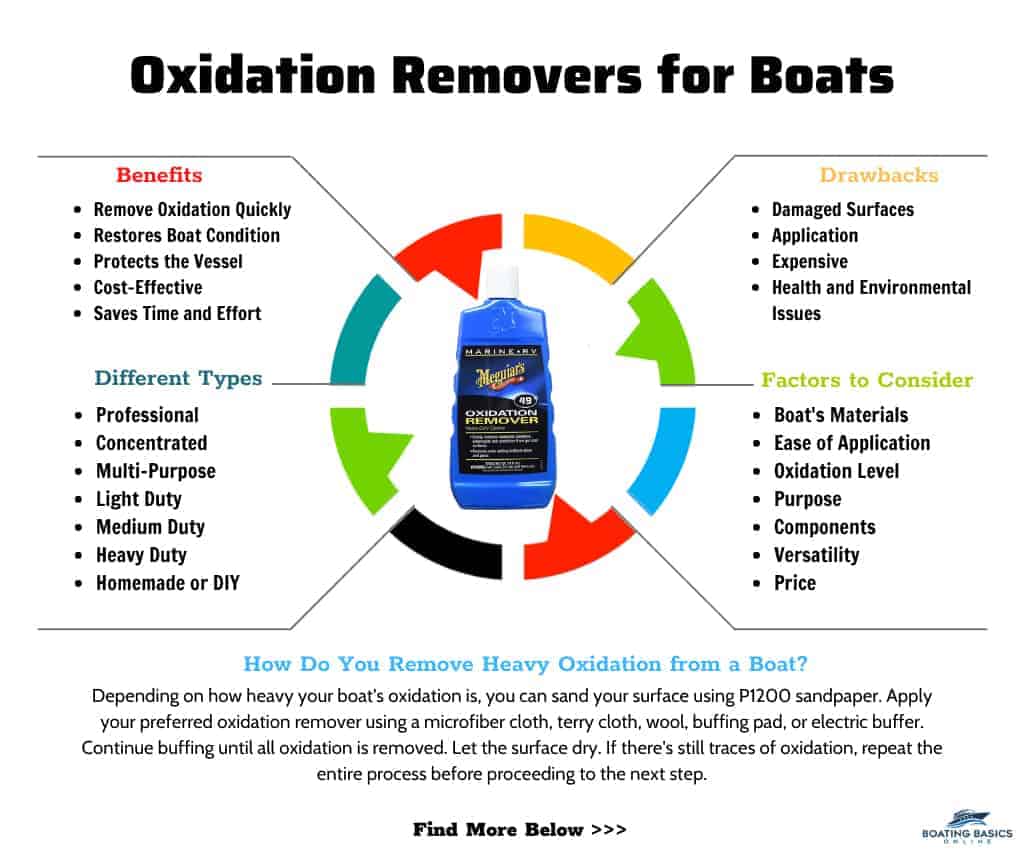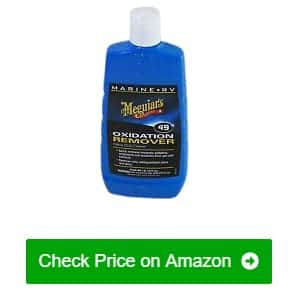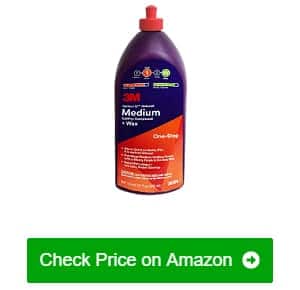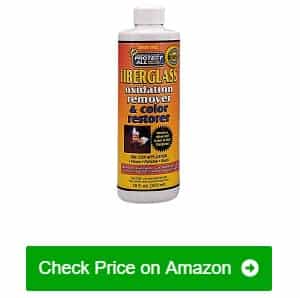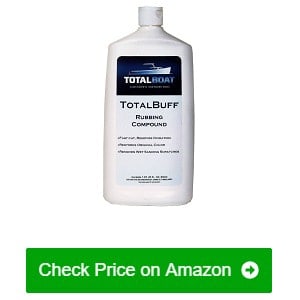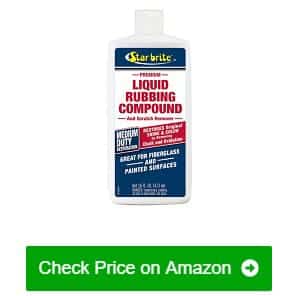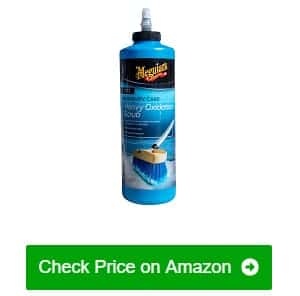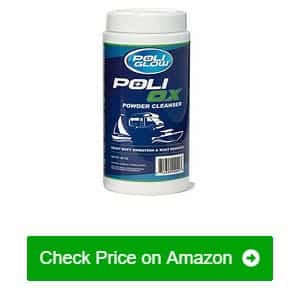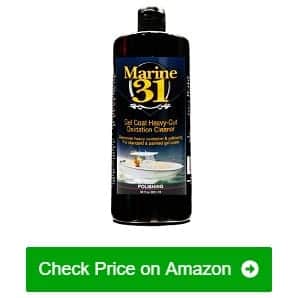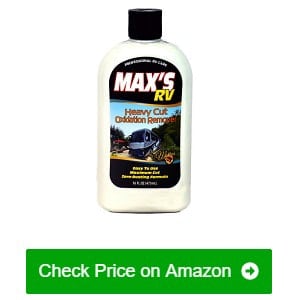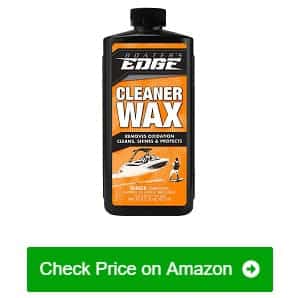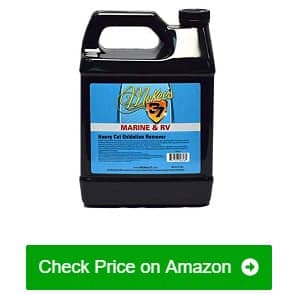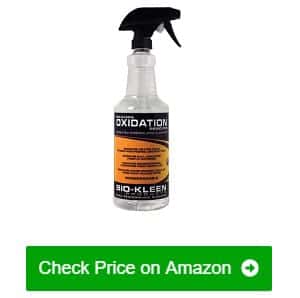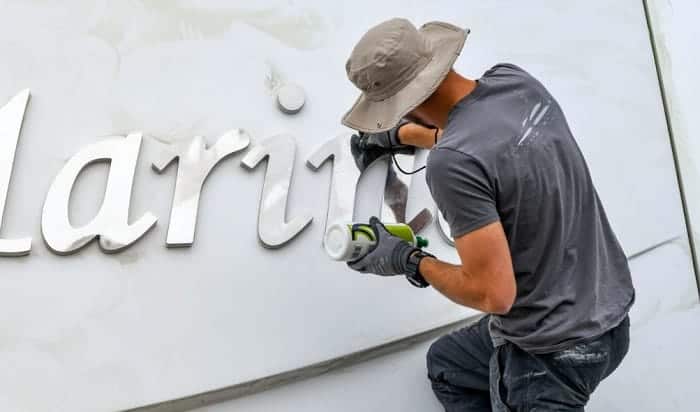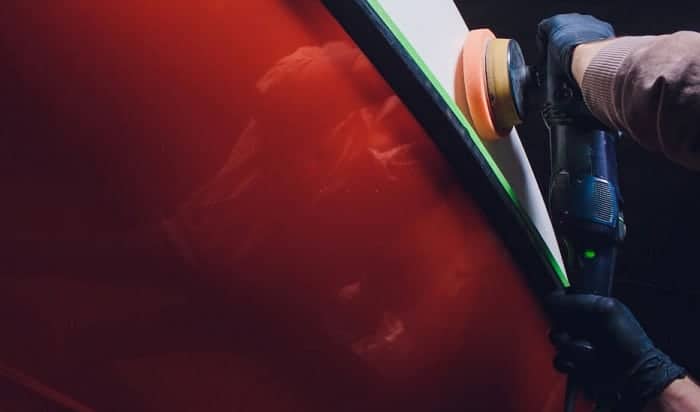Are you looking for an oxidation remover that will bring back the best of your boat? Boat care and maintenance are a bit overwhelming, especially to beginners. Even veteran users find it difficult to choose the appropriate oxidation remover for their vessels. There will always be a time when you shift to other products, even if you already have a trusted brand in mind.
It usually is tempting to buy any of the products you see online or at your local store, especially if it is cheap. However, this kind of attitude will only increase your boat maintenance cost. Hence, I created this review of the best oxidation remover for boats.
- Easy and safe to apply
- Restores the shine
- Enhances the color of surfaces
- Premium two-in-one action formula
- Offers lasting protection
- Suitable for cutting, polishing
- Multi-purpose one-step formula
- Restores the shine and color
- Safe to use on surface materials
Table of Contents
- Best Oxidation Remover For Boats Reviews
- 1. Meguiar’s M4916 Oxidation Remover
- 2. 3M 36106 Perfect-It Gel coat
- 3. Protect All 55016 Oxidation Remover
- 4. TotalBoat Rubbing Compound
- 5. STAR BRITE Rubbing Compound
- 6. Meguiar’s M77132 Oxidation Scrub
- 7. Poli Glow Ox Oxidation Remover
- 8. Marine 31 M31-211 Oxidation Cleaner
- 9. McKee’s 37 MKRV-520 Oxidation Remover
- 10. Boater’s EDGE BE1416 Cleaner Wax
- 11. McKee’s 37 Marine & RV MKRV-521 Oxidation Remover
- 12. Bio-Kleen M00707 Oxidation Remover
- Factors To Consider When Choosing Oxidation Removers For Boats
- What Does Oxidation Look Like
- How Do You Remove Heavy Oxidation From A Boat
- How Do You Restore A Heavily Oxidized Gel Coat
- How Do I Prevent Oxidation
- Should I Wear Gloves When Applying An Oxidation Remover
- Will Vinegar Remove Oxidation From Fiberglass
- Does WD 40 Remove Oxidation
- Conclusion
Best Oxidation Remover For Boats Reviews
1. Meguiar’s M4916 Oxidation Remover
Meguiar’s is a trusted brand when it comes to boat care and maintenance. I came across this oxidation remover while browsing for boat oxidation removal products online. Honestly, this gel coat oxidation remover’s features are promising.
What I like most about this oxidation remover is it is easy and safe to apply by hand or buffing machine. I used a terry cloth towel and spread it on one section at a time. It is also effortless to wipe off unless you put too much solution on it. I suggest applying a thin coating to ensure uncomplicated clean-up.
On the other hand, this product is designed with distinctive diminishing abrasives. Thus, it effectively removes light to moderate oxidation without damaging your target surface. Moreover, it restores the shine of a fiberglass boat because of its unique formula and enriched lubricants.
It also enhances the color of gel coated surfaces. After using this oxidation remover, I noticed that my boat has a deeper hue than it was before. Further, I applied this by hand instead of an electric buffer because I like the finished color and shine more by hand than the buffer.
- Easy and safe to apply by hand or buffing machine
- Removes light to moderate oxidation
- Restores the shine of a fiberglass boat
- Enhances the color of gel coated surfaces
- Designed with distinctive diminishing abrasives
- Not formulated for heavy oxidation
2. 3M 36106 Perfect-It Gel coat
3M has always been my go-to brand when cleaning my boats. If you want to clear oxidized surfaces in just a simple step, this oxidation remover offers a top-notch and fast-acting performance. Even professionals attest to its output and reliability.
This oxidation remover is easy to apply by hand and buffing machine. If you are dealing with smaller areas, using your hand is enough. However, cleaning larger sections requires a buffer for the best results. I also like how the wax stays wet for an extended period, allowing more time to compound any surface. Moreover, wiping its residue is hassle-free.
This is among the best boat wax for oxidation as it is designed with a premium two-in-one action formula. It removes light to moderate oxidation and scratches, and it also offers lasting protection for boat surfaces.
I like that it is suitable for cutting, polishing, and waxing, making it more cost-effective and efficient than other oxidation removers. In addition, the glossy and clean finishing not only made my boat attractive but also strong against marine elements.
Last but not least, it is ideal for all non-silicone-sensitive gel coat surfaces. Thus, I can work comfortably without worrying that it may strip or degrade my gel coating when applied carelessly.
- Easy to apply by hand and buffing machine
- Designed with a premium two-in-one action formula
- Removes light to moderate oxidation and scratches
- Offers lasting protection for boat surfaces
- Suitable for cutting, polishing, and waxing
- Ideal for all non-silicone-sensitive gel coat surfaces
- Cleanup may be challenging
3. Protect All 55016 Oxidation Remover
If you are dealing with fiberglass surfaces, then this one gives outstanding results. I am fond of this oxidation remover for fiberglass because of its excellent qualities on par with other more expensive oxidation removers.
This product is easy to use and apply. I tried it using an unused cloth and buffed it by hand. My advice when using this is to take one section at a time. It may take some time to finish, but the results are superb. You can also use an electric buffer if you prefer.
What I really like about this is it is engineered as a multi-purpose one-step formula. It eliminates oxidation and wax buildup while it restores the shine and color of boat surfaces. Plus, it provides protective finishing on target surfaces against outside elements.
Safe to use on various surface materials, including fiberglass, gel coat, and painted aluminum, is another feature I love about this product. Moreover, it works on polyurethane and enamel materials, making it more flexible and convenient to use than other oxidation removers.
- Easy to use and apply
- Engineered as a multi-purpose one-step formula
- Eliminates oxidation and wax buildup
- Restores the shine and color of boat surfaces
- Provides protective finishing on target surfaces
- Safe to use on various surface materials
- Not intended for soft clear coat surfaces use
4. TotalBoat Rubbing Compound
My sailboat has five years of oxidation, and I have tried various oxidation removers, from homemade removers to heavy-duty oxidation removers. Fortunately, a friend told me about this product from TotalBoat. Its outcome exceeded my expectations.
Most rubbing compounds I used before are a bit challenging to utilize. That’s why I like this oxidation remover for metal, as it is quick to use and apply. Section by section, I applied the solution, let it form into a haze, and used an electric buffer. My advice is to shake the solution well to ensure its efficacy and consistency.
I also like how it eliminates heavy oxidation and wet sanding scratches. Boaters tend to wet sand aggressively, causing unnecessary scratches. So, this is a total lifesaver if you are among such boaters. Moreover, it is formulated as a fast-cutting compound that removes heavy swirls and works on different materials like painted surfaces.
Additionally, it restores boats’ colors excellently. It makes your boat cleaner and brighter at the same time. I noticed that my boat’s hull has its original color, but its shade is more profound than before. I find this impressive to think that I didn’t follow it up with any finishing compound.
- Quick to use and apply
- Eliminates heavy oxidation and wet sanding scratches
- Formulated as a fast cutting compound
- Restores boats’ colors
- Works on different materials like painted surfaces
- May require multiple applications
5. STAR BRITE Rubbing Compound
I will always include this liquid oxidation remover in my recommendations of the best boat oxidation remover. I’ve been using this for over eight years now, and its performance is consistent. My boat has heavy oxidation, and this unit solved my problem.
Its straightforward usage and application are what impress me a lot. You can easily apply it by hand or by a mechanical buffer, but I prefer using my hand with a buffing pad. I washed the surface and pulled out any dirt and wax build-ups before application to ensure even compounding. Please note that you have to rub while the mixture is wet and let it dry into a haze before buffing. However, the solution doesn’t dry up too quickly, allowing you to work through small sections evenly and wipe them off quickly.
It removes light to medium oxidation and scratches effectively. It also revives the boat’s color and luster, making it to every boater’s preferred boat oxidation remover. What’s striking about this oxidation remover is its consistency is not too thin nor too thick, which offers a broader coverage area than other removers. This product is also safe to use on fiberglass and painted surfaces.
- Straightforward usage and application
- Removes light to medium oxidation and scratches
- Revives the boat’s color and luster
- Offers a broader coverage area
- Safe to use on fiberglass and painted surfaces
- Stubborn oxidation requires several applications
6. Meguiar’s M77132 Oxidation Scrub
Removing boat oxidation is always a problem for every boat owner, specifically if you are not equipped with the best oxidation removers for boat. However, when I discovered this gel coat oxidation remover, eliminating oxidation on various surfaces was never an issue.
It is simple to use and apply. Like other oxidation removers, this works flawlessly when you work on small areas at a time. I applied it on my boat’s hull with a soft-bristled brush and scrubbed the space until I removed oxidation. After that, I rinsed it with water thoroughly and wiped it with a clean cloth.
I am a fan of this remover as it revives oxidized gel coat, fiberglass, and non-skid surfaces. It is also non-abrasive on gel coating and sensitive materials. So you can work comfortably without thinking about damaging your boat ultimately.
The most outstanding feature of this remover is it is formulated with a water-soluble solution and made with biodegradable substances. Therefore, you can work near the waters or at the dock as its chemical components will not harm marine life.
- Simple to use and apply
- Revives oxidized gel coat, fiberglass, and non-skid surfaces
- Non-abrasive on gel coating and sensitive materials
- Formulated with a water-soluble solution
- Made with biodegradable substances
- May require extensive scrubbing
- Finishing shine is a bit dull
7. Poli Glow Ox Oxidation Remover
For boaters asking me how to remove heavy oxidation from fiberglass boats, this oxidation remover would be my answer. It is convenient to use and apply. I prepared my boat by wetting the surface and the scrub pad. After that, I sprinkled the powder onto the pad and scrubbed it onto the surface. Once done, I rinsed it with water and dried the surface with a clean cloth.
This unit stood out for me among the best fiberglass oxidation removers in the market because it is formulated as a powder cleanser. I, mostly, worked with either liquid or wax substances before. So, when I saw that it comes in a powder form, I find it unique and exciting to use.
Unsurprisingly, it eliminates light to heavy oxidation. It even cleans tough stains on various surfaces. I often have problems with fish blood, rust stains, exhaust stains, and oxidation. Thankfully, this oxidation remover helped a lot in clearing any damaged areas, such as my boat’s fiberglass surface and stainless steel parts.
Besides that, I was hooked on buying this because it includes a few scrub pads and a scrubber. I noticed that the two 3M fine scrub pads work excellently on heavy oxidation. You can also use the scrubber with a handle if you prefer.
- Convenient to use and apply
- Formulated as a powder cleanser
- Eliminates light to heavy oxidation
- Cleans tough stains on various surfaces
- Includes a few scrub pads and a scrubber
- Contains harmful and abrasive chemicals
8. Marine 31 M31-211 Oxidation Cleaner
Eliminating oxidation and other marine stains were challenging until I came across this Marine 31 oxidation remover. This works on standard and painted surfaces, but I would still advise a patching test first before applying it on large oxidized surfaces.
The first thing I like about this oxidation remover is its easy usage and application. I tried applying this by hand, but I wasn’t impressed with the results. So, I followed the label instructions and used a rotary buffer to finish the rest of the boat. Surprisingly, using it with a machine gives a more spectacular outcome.
It removes oxidation and yellowing, which I find challenging to eliminate using other oxidation removers. It also restores the shine of every boat I applied it with because it has lubricating oils. Although it leaves your boat a shiny finishing, I would still recommend using a separate polish to complete your restoration process.
Its most commendable feature is it is engineered with advanced diminishing abrasives and eco-friendly formula. As a result, you will not be guilty of threatening marine life, even when you clean near the water. Moreover, its solution is powerful to break down oxidation and abrasives, leaving your boat sparkling clean.
- Easy usage and application
- Removes oxidation and yellowing
- Has lubricating oils
- Restores the shine of every boat
- Works on standard and painted surfaces
- Engineered with advanced diminishing abrasives and eco-friendly formula
- Best results need intensive labor
9. McKee’s 37 MKRV-520 Oxidation Remover
If you ask me about my best fiberglass oxidation remover list, this heavy cut oxidation remover is indeed included in my list. Like other oxidation removers, it is easy to use and apply. I used an electric buffer to apply the solution and wiped it off using a clean cloth. Even without a separate polish, the finishing is impressive.
It cuts through heavy oxidation and yellow stains even with only a little elbow grease. I bought a severely oxidized boat last year, and this cleaner worked great. This heavy cutting compound with nourishing lubricants penetrates stubborn stains and oxidation.
It also offers a long buffing cycle. I can finish buffing the affected surface without rushing it. Additionally, it is less aggressive than other oxidation removers. It may have a powerful formula, but it is still gentle on different boat surfaces. Furthermore, it revives the boat’s overall condition with its cleaning component and polishing oils.
- Easy to use and apply
- Cuts through heavy oxidation and yellow stains
- Heavy cutting compound with nourishing lubricants
- Offers a long buffing cycle
- Less aggressive than other oxidation removers
- Revives the boat’s overall condition
- Available in one size only
10. Boater’s EDGE BE1416 Cleaner Wax
This boat wax was recommended by a friend when I asked him for an all-in-one oxidation remover. Since it came from a reliable brand, I didn’t have doubts about buying it. Thankfully, its performance did not disappoint. It is also safe to use on gel coat, painted, and clear coat surfaces.
I am a fan of its straightforward usage and application. You can apply it by hand or electric buffer and wipe it off with a clean towel. I suggest preparing your surface by washing it before you start the process. This wax dries off quickly. So, work your way by small sections.
What stood out in this cleaner is it is engineered as a lasting three-in-one action formula. By applying this solution, you can quickly clean, shine, and protect your boat. I also noticed that it removes oxidation pretty fast compared to other removers. The results reminded me of the Leprechaun Magic oxidation remover.
More so, it restores the boat’s luster. In my case, I tried this on my moderately oxidized boat, and after a complete process, I was able to see my reflection through it. Additionally, it shields the surface against UV rays or water and oil-based stains. Thus, while cleaning is its primary purpose, it leaves a protective layer against extreme sunlight and severe water and oil staining.
- Straightforward usage and application
- Engineered as a lasting three-in-one action formula
- Removes oxidation pretty fast
- Restores the boat’s luster
- Shields the surface against UV rays or water and oil-based stains
- Safe to use on gel coat, painted, and clear coat surfaces
- Desirable outcomes may need extensive effort and time
11. McKee’s 37 Marine & RV MKRV-521 Oxidation Remover
This oxidation remover is among the best boat oxidation removers, with promising results if you are looking for utility and versatility. Also, I am fond of how it is easy to use and apply, even if you’re new to the world of boating.
I had a severely oxidized hull, and it took me a few hours to finish the entire hull as I worked on small areas at a time. Like other removers in this list, I applied this using an electric buffer and wiped it off with a microfiber cloth. If you worked on the entire section simultaneously, I suggest spraying a little bit of water on it while buffing to avoid hassle when removing its residue.
I love this RV oxidation remover because it lifts off dirt, grimes, scratches, and stains. It eliminates mild to severe oxidation as well. It is a dual-acting formula but works in just one step. Moreover, you can use this on your marine vessels and RVs.
I also like this versatile oxidation remover as it is formulated with nourishing oils. With these nourishing lubricants, this oxidation remover has a long buffing cycle. You can buff the surface for a long time to achieve the best results.
- Easy to use and apply
- Lifts off dirt, grimes, scratches, and stains
- Eliminates mild to severe oxidation
- Formulated with nourishing oils
- Has a long buffing cycle
- The solution needs to be transferred for easy application
12. Bio-Kleen M00707 Oxidation Remover
This is one of my favorites among other fiberglass boat oxidation removal products I used before. It worked great on every part of my boat. I’ve been using this for over five years, and its performance, utility, and versatility do not disappoint.
I think many will like this because of its simple usage and application. All you need to do is spray it on your target surface and wipe off its residue. Of course, sitting time depends on the oxidation’s severity. I dealt with tough oxidation and let the formula do its wonders for five minutes before wiping it off.
I was impressed that it easily removes oxidation, yellow haze, and scum lines. Another great feature about this oxidation remover is that it eradicates oxidation, marine stains, spider stains and bird droppings.
Apart from that, it is safe to use on gel coats and fiberglass boats. This product comes in a weather-proof nozzle spray bottle as well. Henceyou can store it for a long time as the formula won’t harden, or the seal won’t be stuck, even in different seasons.
Personally, I always prefer to use marine cleaners that are environmentally friendly. So I didn’t have second thoughts about using this as it has a biodegradable formula. You can clean comfortably near the waters as its mixture will not harm marine life.
- Simple usage and application
- Removes oxidation, yellow haze, and scum lines
- Eradicates spider stains and bird droppings
- Safe to use on gel coats and fiberglass boats
- Comes in a weather-proof nozzle spray bottle
- Has a biodegradable formula
- Emitting an unpleasant smell
Factors To Consider When Choosing Oxidation Removers For Boats
Using an oxidation remover is an essential thing for any boat owner. So it would be great if you know the critical factors when choosing the best boat oxidation removers. Narrowing down your options may be challenging, but the pointers below will enlighten your decisions.
- Boat’s Materials
You should always first consider your boat’s materials when choosing an oxidation remover. Not all removers are compatible with every boat material. If you decide carelessly, you may damage the surface and cause further destruction of your boat.
Some removers are intended for specific materials. For example, a fiberglass oxidation cleaner will work on fiberglass surfaces but not on painted materials. Similarly, a gel coat cleaner may not be compatible with aluminum.
If you try working with incompatible removers and surfaces, it will only incur additional expenses and, worst, shorten your boat’s life span. Thus, always read the label and try the solution on an inconspicuous area before going all in.
- Ease of Application
Another thing to consider is its ease of application. Every oxidation remover I listed above is easy to use and apply either by hand or an electric buffer. Always go for products with straightforward usage and application to save your time and effort in clearing oxidation.
Additionally, select products that don’t require heavy scrubbing and a longer waiting time. It is more economical to buy a remover that works in one application than to stick to an effective product that gives the best results only after multiple applications.
- Oxidation Level
The next point to consider is your boat’s oxidation level. Choose an oxidation remover that matches the severity of your boat’s oxidation. Rate your oxidation from light to heavy, and select the appropriate remover for such a level. If you are unsure of its effectiveness, I suggest choosing a remover that is higher than your boat’s oxidation level.
- Oxidation Remover’s Purpose
Now that you are aware of your boat’s oxidation severity, you can now choose the purpose of your oxidation remover. If you are dealing with moderate oxidation, then go for medium-duty removers. Besides that, it is vital to consider the other functions of your preferred oxidation remover. Pick a product that offers various benefits other than eradicating oxidation, like polishing and protecting your boat.
- Oxidation Remover’s Components
I find this factor the most neglected point of every boat owner. Many are not looking for the remover’s ingredients and just buying one depending on its effectiveness. However, it is also essential to consider its components to ensure your personal, boat, and environmental safety.
- Versatility
Another feature to consider is the product’s versatility. I prefer using an oxidation remover that is not only applicable to marine vessels but also RVs and automobiles. Fortunately, many products in the market offer versatile applications.
- Price
If you are tight on budget, then considering its price would be beneficial. The reason I placed this factor as the last thing to consider is that you can determine whether the price is high or low depending on the factors mentioned earlier. So if it’s a little pricey, but
The Different Types of Oxidation Remover
There are two general types of oxidation removers available today. We have professional oxidation removal products and homemade or DIY oxidation removers. However, keep in mind that both kids have their own advantages and disadvantages. So, I suggest using them at your own risk.
- Professional Oxidation Removers
These are ready-made oxidation removers that you can find at online shops or your local stores. While others are made with biodegradable and environment-friendly substances, most professional oxidation cleaners are formulated with powerful and harsh chemicals to remove oxidation effectively.
Based on its form, this type is divided into three categories. The categories are as follows:
- Liquid Form
- Wax Form
- Powder Form
Professional oxidation cleaners are also widely categorized based on their purpose. Below are the two classifications:
- Concentrated Oxidation Removers
Oxidation removers that focus on a single purpose fall into this category. Many removers are designed to remove oxidation, including its after-effects like rust stains and chalking. These are the primary and most affordable oxidation removers in the market.
- Multi-Purpose Oxidation Removers
The best boat oxidation removers do not deal with oxidation alone, like those included in this category. These removers offer various benefits other than removing oxidation, such as polishing your boat and protecting its surface against outside elements. Choosing such removers is an excellent investment.
Output-wise, professional oxidation removers can be divided into three kinds. Here are the subcategories:
- Light Duty Oxidation Remover
This is the least common type among the three. Most oxidation removers are designed to deal with moderate to severe stains and oxidation. If your oxidation is mild, you can use such removers to achieve your desired result.
- Medium Duty Oxidation Remover
Oxidation removers in this type are the second most used products as many boaters can use these to remove oxidation that is slightly severe than light oxidation. Plus, if you are dealing with only less oxidation, this type is ideal to ensure the best results rather than risk buying the light-duty ones.
- Heavy Duty Oxidation Remover
This type is the most preferred type of boat owners as it covers light to heavy oxidation. When choosing boat oxidation removers, it would be best to go for more than what your boat’s oxidation needs rather than to settle on what you only think your boat needs. However, you still need to consider its substances to avoid boat deterioration.
- Homemade or DIY Oxidation Removers
If you are not a fan of using strong chemicals on your boat in removing oxidation, then going for homemade oxidation removers is the best alternative for you. However, such removers do not guarantee outstanding results. They may help but only to some extent.
But if you are okay with putting your time in removing oxidations to avoid spending on expensive oxidation removers, you can use those in this category. The most common example of homemade or DIY oxidation remover is the vinegar solution.
Benefits and Drawbacks of Using Oxidation Remover
Oxidation removers, like other marine care and maintenance products, have their advantages and downsides. Knowing these beforehand is beneficial to prepare yourself on what to expect on oxidation removers and avoid disappointment. So let’s start with their benefits.
- Remove Oxidation Quickly
The primary purpose of an oxidation remover is to remove oxidation quickly, as much as possible. Although others may take several applications before you achieve the best results, using an oxidation remover is the fastest way to combat such problems.
- Restores Boat Condition
Whether you choose a multi-purpose or single-purpose oxidation remover, it will restore your boat’s condition as a result. Other removers may give you a better version of your vessel after application, while some may revive it to its original condition.
- Protects the Vessel
Choose an oxidation remover that offers maximum benefits, and you will be able to protect your vessel against weathering and other marine elements. Furthermore, most removers will leave a protective finishing after you complete the entire restoration process.
- Cost-Effective
Using an oxidation remover is more economical than hiring a professional boat cleaner. Although you have to do the work yourself, it is still an excellent way to save money. Plus, it helps educate yourself about your boat and solve your problem without always relying on professionals.
- Saves Time and Effort
Besides money, time and effort are also at stake when removing oxidation. Fortunately, most removers are efficient and offer exceptional ease of usage and application, allowing you to achieve your desired outcome quickly.
Now that you know the good things you can obtain from using oxidation removers, it is also helpful to inform yourself about their possible cons. Here are a few of their disadvantages.
- Damaged Surfaces
If you are not cautious enough in using an oxidation remover, you may encounter damaged surfaces more often. Some removers have harsh chemicals that can harm sensitive materials. Thus, it would help if you choose an oxidation remover that matches your boat’s material.
- Application
Some removers are challenging to utilize because of their components. Others may dry up too quickly, causing difficult residue removal. Moreover, other removers have thick consistencies that lead to uneven application. So, I suggest choosing the most appropriate cleaner you feel comfortable working with.
- Expensive
I know I said earlier that using an oxidation remover is cost-effective. However, some removers are costly, especially those that come in small-sized bottles. Hence, I always suggest buying large removers so you can use them on large projects for an extended period.
- Health and Environmental Issues
Another major drawback of using an oxidation remover is it poses health and environmental issues. As most removers are formulated with harsh and combustible substances, users become prone to skin or eye irritation and respiratory problems.
These substances also damage the aquatic environment, especially if you are cleaning near the waters. Therefore, if your oxidation remover has hazardous caution, always wear full protective gear and, as much as possible, do not dump your discards on the water.
Its benefits are overflowing, then it might not be a bad idea to go for it.
What Does Oxidation Look Like
We all know that oxidation is a serious issue that needs to be resolved before it destroys your boat. However, what causes oxidation, and what does it look like? My first years of boating were pretty challenging and complicated because I know nothing about boats.
I didn’t even know that the boat I bought had years of oxidation. Fortunately, a professional nearby taught me a thing or two about oxidation. Let’s break it all down now. Oxidation is caused by various situations, such as prolonged exposure to changing environments, bird droppings and spider stains, and even chemical reactions.
Although the results may not be seen instantly, constantly neglecting these roots may develop into a severe problem. Now, how would you know if it’s oxidation? The oxidation appears typically differently depending on your boat’s material.
Oxidation on gel coat appears as a white dust or chalky residue. You may also notice some discoloration or dullness on it. When this happens, ensure that you use a designated remover for such problems and material. On the other hand, oxidation may appear with rust or yellow stains. Yellowing of your boat’s hull or surface is a sign that it is already suffering from oxidation. If left untreated, oxidation may get severe.
So, how would you know your boat’s oxidation level? A trick I learned from my years of boating is to touch the oxidized part. When you pat the area, and nothing is transferred to your finger, you’re probably at the starting point. Medium oxidation is when a small amount of stains is transferred to your finger upon contact. If the amount is substantial, then you’ll be needing heavy-duty removers.
How Do You Remove Heavy Oxidation From A Boat
Besides obtaining a suitable oxidation remover, there are some steps that you should follow when you have this kind of issue. Here are the simple procedures on how to remove heavy oxidation from a boat:
- Depending on how heavy your boat’s oxidation is, you can sand your surface using P1200 sandpaper. This grit can remove heavy oxidation, but it can also cause abrasions or scratches on your boat. So, always be cautious when doing this part.
- Apply your preferred oxidation remover using a microfiber cloth, terry cloth, wool, buffing pad, or electric buffer. Scrub the surface in a circular or downward motion. Whatever way is best, always do it in a single direction.
- Continue buffing until all oxidation is removed. Depending on your oxidation remover, wipe off its residue using a clean cloth or rinse it with water thoroughly.
- Let the surface dry. If there’s still traces of oxidation, repeat the entire process before proceeding to the next step.
- For best results, follow your remover with a polish or wax. This will give your boat luster and protection. Some removers are formulated to do the cleaning, polishing, and protecting in just a single application. So, it would help if you look for such a remover.
How Do You Restore A Heavily Oxidized Gel Coat
With the proper oxidation remover, you can lessen your entire working time but still achieve the best results. Follow the steps below to restore your gel coat:
- Prepare the surface by wet sanding. Wet sanding is for severe issues as heavy oxidation needs an abrasive method. If you don’t like such a method, you can always choose a less aggressive option, which is to use a compound that will soften and lift off the oxidation.
- Apply the remover in a small section of the surface. This trick is a proven method to achieve your desired result. Working your way slowly to finish the entire surface is a bit tiring and time-consuming, but the results are always worth it.
- Continue rubbing the surface using a buffer or a clean cloth in a singular motion. Change your pad when it becomes unclean to prevent sending back the oxidation onto the surface.
- After that, wipe off its residue completely. Check if oxidation is removed. Once done, you can proceed to the next step. Otherwise, continue buffing the surface carefully.
- Polish the surface using a polisher to remove any marks caused by buffing or sanding the surface. This step will give your boat a shiny finishing.
- To complete the process, use a marine sealant to protect the surface from future damages like weathering, UV degradation, and stain buildups.
How Do I Prevent Oxidation
Generally, the key to preventing oxidation in a boat is proper care and maintenance. You should treat your boat like a living body that needs delicate attention and repair. Unfortunately, restoring a damaged ship incurs higher expenses than maintaining its condition. To avoid spending too much money and time, let me show you some simple reminders to prevent oxidation.
First, wash and clean your boat regularly. A human being needs to take a bath daily or at least every other day. Similarly, your boat needs a good wash to eradicate oxidation easily. If you clean your boat regularly, you will quickly notice the starting signs of oxidation. Although you cannot cure it by simply washing your boat, you can still manage oxidation effectively when you wash your boat regularly.
Second, store your boat in a place where it is not prone to environmental changes. This may be tricky because even if you place your vessel in enclosed storage, the humidity inside will still cause damage to your boat. The key to this step is to find a space where the sun doesn’t shine directly on it. Additionally, cover your boat so that animal dropping or stains will not hit your boat directly. Further, as much as possible, do not leave your boat on the waters for an extended period. If this is unavoidable, ensure to clean or wash your craft constantly.
Last, create a waxing or polishing schedule for your boat. Usually, once a year is enough, but if your place is prone to harsh outside elements, then waxing your boat accordingly is necessary. This step helps protect your boat against surface damage.
Should I Wear Gloves When Applying An Oxidation Remover
An oxidation remover may contain hazardous substances that cause eye or skin irritation, respiratory issues, and even cancer. Hence, I suggest wearing gloves when applying an oxidation remover. It is okay not to wear gloves if you use a biodegradable remover and are not sensitive to chemicals.
However, as the saying goes, prevention is better than cure. Therefore, every time I clean my boat with an oxidation remover, I always wear my full protective gear, like goggles, masks, and gloves, to prevent possible health issues.
Will Vinegar Remove Oxidation From Fiberglass
Homemade or DIY oxidation cleaners are effective in fighting off oxidation. For example, vinegar has an acidic substance comparable to oxalic acid, which is commonly found in commercial oxidation cleaners. The chemical components of vinegar are effective in combating mild oxidation. However, years of oxidation may require an advanced cleaner like the ones listed above.
You can also try making vinegar and baking soda mixture to fight against oxidation in fiberglass. The major drawback of using concentrated vinegar or this mixture is that it may damage your fiberglass while cleaning it.
The chemical reaction of both compounds may harm your fiberglass. Moreover, vinegar and baking soda alone can cause abrasions or scratches on your fiberglass. Generally, vinegar will work on your fiberglass. It will also remove unwanted dirt, stains, and grimes. However, you have to be careful, and you need to do it right to avoid further damage.
Does WD 40 Remove Oxidation
I am not a fan of WD 40, but yes, it can eradicate oxidation. It can also remove rust, grease, and stains. However, it may severely damage your boat, especially if your boat’s material is sensitive.
Conclusion
As a quick brush-up, the best oxidation remover for boats is versatile. It should not only eradicate oxidation but also eliminate its after-effects and early signs. It should also polish and protect your boat and prolong your boat’s life span. I hope that this review comes to your aid when you find choosing an appropriate remover challenging.

“I am James Harvey – founder of Boating Basics Online. It is established with the drive to help out first-time boaters, which are those desiring to explore their way through the water. So if you are new to boating, start from here with me. “


